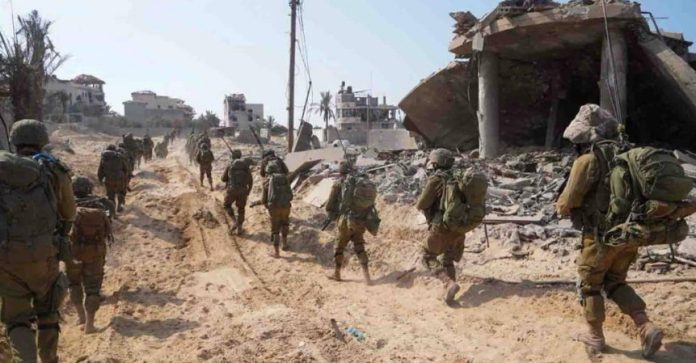On Sunday, the Israeli military said it had surrounded Gaza City and divided the besieged coastal strip into two parts, the entire Gaza Strip suffered a complete communications blackout for the third time in the Israeli-Hamas war.
Rear Adm. Daniel Hagari told reporters, calling it a “significant stage” in Israel’s war against the Hamas militant group ruling the enclave:
“Today there is north Gaza and south Gaza.”
Heavy explosions were seen in northern Gaza after dark. Israeli media reported that troops were expected to enter Gaza City within 48 hours. A “communications collapse” across the Gaza Strip, reported by the Internet access protection group NetBlocks.org and confirmed by the Palestinian telecommunications company Paltel, made it even more difficult to relay details of the new phase of the military offensive.The first outage in Gaza lasted 36 hours, the second one for a few hours. UN Palestinian refugee agency spokesperson Juliette Touma told The Associated Press:
“We have lost communication with the vast majority of the UNRWA team members.”
Earlier on Sunday, Israel launched airstrikes on two refugee camps, killing at least 53 people and wounding dozens more in central Gaza, an area where the Israeli military has urged Palestinians to seek refuge, health officials said. Israeli authorities said they would continue the offensive to defeat Hamas, despite US calls for at least short pauses to deliver aid to desperate civilians.
The Gaza Health Ministry reports that more than 9,700 Palestinians have died in nearly a month of war in Gaza, including more than 4,000 children. That number is set to rise as Israeli troops advance into dense urban neighbourhoods.
Airstrikes on the Maghazi refugee camp killed at least 40 people and wounded 34 others. Correspondents at a nearby hospital saw eight dead children, including an infant, who were brought there after the strike. The surviving child was being led down a corridor, covered in dust.
According to Arafat Abu Mashaya, a refugee who lives in the camp, an Israeli airstrike burned down several multi-storey houses sheltering people who had fled from other parts of Gaza. He said:
“It was a true massacre. All here are peaceful people. I challenge anyone who says there were resistance (fighters) here.”
Israeli army officials had no comment on the situation.
Another airstrike on a house near a school in the Bureij refugee camp in central Gaza killed at least 13 people.
Despite numerous calls and protests from abroad, Israel has continued its bombardment of the Gaza Strip, saying Hamas is the target and accusing militants of using civilians as human shields. However, critics say Israel’s strikes are often disproportionate given the high number of civilian deaths.
Israeli troops in the Gaza Strip report finding caches of weapons, including explosives, suicide drones and rockets, as they advance. The Israeli military said 29 of its soldiers were killed in the ground operation.
The Israeli military said a one-way corridor for residents to flee to southern Gaza would continue.
According to the UN, some 1.5 million Gazans, or 70 per cent of the population, have fled their homes. Food, water and fuel needed for generators powering hospitals are running out. According to the UN Agency for Palestinian Refugees, fuel has not arrived for almost a month.
